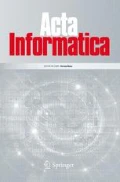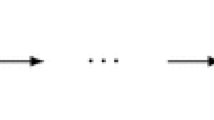Summary
In this paper, information theoretic inference methology for system modeling is applied to estimate the probability distribution for the number of customers in a general, single server queueing system with infinite capacity utilized by an infinite customer population. Limited to knowledge of only the mean number of customers and system equilibrium, entropy maximization is used to obtain an approximation for the number of customers in the G¦ G¦1 queue. This maximum entropy approximation is exact for the case of G=M, i.e., the M¦M¦1 queue. Subject to both independent and dependent information, an estimate for the joint customer distribution for queueing systems in tandem is presented. Based on the simulation of two queues in tandem, numerical comparisons of the joint maximum entropy distribution is given. These results serve to establish the validity of the inference technique and as an introduction to information theoretic approximation to queueing networks.
Similar content being viewed by others
References
Cohen, J.W.: The Single Server Queue. Amsterdam: North Holland 1982
Kleinrock, L.: Queueing Systems. Volume 1: Theory. New York: John Wiley 1975
Cooper, R.B.: Introduction to Queueing Theory. New York: North Holland 1981
Syski, R.: Introduction to Congestion Theory in Telephone Systems. London: Oliver and Boyd 1960
Kleinrock, L.: Communication Nets. New York: McGraw-Hill 1964
Tanenbaum, A.S.: Computer Networks. New Jersey: Prentice-Hall 1981
Trivedi, K.S.: Probability and Statistics with Reliability, Queueing and Computer Science Applications. New Jersey: Prentice-Hall 1982
Shore, J.E.: Derivation of equilibrium and time-dependent solutions of queueing systems using entropy maximization. Proceedings 1978 National Computer Conference, pp. 483–487. AFIPS 1978
Shore, J.E., Johnson, R.W.: Axiomatic derivation of the principle of maximum entropy and the principle of minimum cross-entropy, IEEE Trans. Inf. Theory, 26, 26–37 (1980) (See also comments and corrections in IEEE Trans. Inf. Theory, 29, 942–943 (1983))
Beneš, V.E.: Mathematical Theory of Connecting Networks and Telephone Traffic. New York: Academic Press 1965
Ferdinand, A.E.: A Statistical Mechanics Approach to Systems Analysis. IBM J. Res. Dev. 14, 539–547 (1970)
Shore, J.E.: Information Theoretic Approximations for M¦G¦1 and G¦G¦1 Queueing Systems. Acta Inf. 17, 43–61 (1982)
El-Affendi, M.A., Kouvatos, D.D.: A Maximum Entropy Analysis of the M¦G¦1 and G¦M¦1 Queueing Systems at Equilibrium. Acta Inf. 19, 339–355 (1983)
Jaynes, E.T.: Information theory and statistical mechanics I. Phys. Rev. 106, 620–630 (1957)
Kullback, S.: Information Theory and Statistics. New York: Dover 1969; New York: Wiley 1959
Csiszár, I.: I-divergence geometry of probability distributions and minimization problems. Ann. Probab. 3, 146–158 (1975)
Shore, J.E., Johnson, R.W.: Properties of cross-entropy minimization. IEEE Trans. Inf. Theory 27, 472–482 (1981)
Johnson, R.W.: Determining probability distributions by maximum entropy and minimum cross-entropy. APL79 Conference Proceedings, pp. 24–29, ACM0-89791-005, May 1979
Shore, J.E.: Cross-Entropy Minimization Given Fully Decomposable Subset and Aggregate Constraints, IEEE Trans. Inf. Theory 28, 956–961 (1982)
Mendenhall, W., Schaeffer, R.L.: Mathematical Statistics with Applications, North Scituate, MH: Duxbury Press 1974
Boxma, O.J.: On a Tandem Queueing Model with Identical Service Times at Both Counters I. Adv. Appl. Probab. 11, 616–643 (1979)
Pinedo, M, Wolff, R.W.: A Comparison Between Tandem Queues with Dependent and Independent Service Times. Oper. Res. 30, 464–479 (1982)
Cantor, J.L.: Information-Theoretic Analyses for a Multi-Server Queueing System at Equilibrium with Application to Queues in Tandem, M.SC. Thesis, Electrical Engineering Dept., Univ. of Maryland, College Park, Maryland 1984
Denning, P.J., Buzen, F.P.: The Operational Analysis of Queueing Network Models. Comput. Surv. 10, 225–261 (1978)
Zahorjan, J.: The Approximate Analysis of Large Queueing Network Models. Tech. Rep. CSR6-122 (Ph.D. Thesis), Univ. of Toronto, Toronto, Ontario 1980
Whitt, W.: The Queueing Network Analyzer. Bell. Syst. Tech. J. 62, 2279–2815 (1983)
Tembe, S.V., Wolff, R.W.: The Optimal Order of Service in Tandem Queues. Oper. Res. 22, 824–832 (1974)
Author information
Authors and Affiliations
Additional information
This work was supported under a Naval Research Laboratory Fellowship under Grant N00014-83G-0203 and under an ONR Grant N00014-84K-0614
Former address:Westinghouse Defense and Electronics Center, Baltimore, MD, USA
Rights and permissions
About this article
Cite this article
Cantor, J., Ephremides, A. & Horton, D. Information theoretic analysis for a general queueing system at equilibrium with application to queues in tandem. Acta Informatica 23, 657–678 (1986). https://doi.org/10.1007/BF00264312
Received:
Issue Date:
DOI: https://doi.org/10.1007/BF00264312




